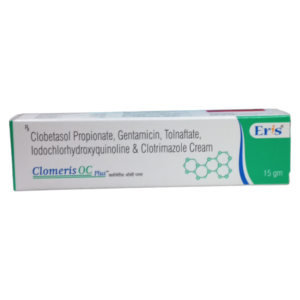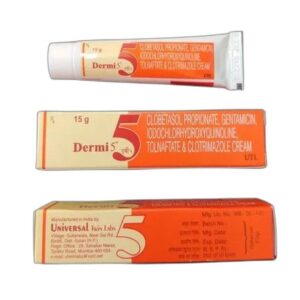TOLNAFTATE + CLOTRIMAZOLE + CLOBETASOL + GENTAMICIN + IODOCHLORHYDROXYQUINOLINE
Tolnaftate: Tolnaftate is an antifungal medication used to treat fungal infections of the skin, such as athlete’s foot, jock itch, and ringworm. It is available over-the-counter in various forms including creams, powders, sprays, and solutions.
The mechanism of action of Tolnaftate involves inhibiting the growth and replication of fungi by interfering with fungal cell membrane synthesis. This disrupts the integrity of the fungal cell wall and ultimately leads to the death of the fungus.
The recommended dose and frequency of application may vary depending on the specific product and the severity of the infection. Generally, Tolnaftate should be applied to the affected area(s) of clean, dry skin 1 to 2 times per day. It is important to carefully follow the instructions provided with the specific product.
Common side effects of Tolnaftate are generally mild and may include skin irritation, redness, itching, or a burning sensation at the site of application. These side effects are usually temporary and go away on their own. If these side effects persist or worsen, it is advisable to consult a healthcare professional.
It is important to note that Tolnaftate is indicated for external use only and should not be ingested or used in the eyes, mouth, or genital area. If symptoms do not improve after a few weeks of treatment or if they worsen, a healthcare professional should be consulted for further evaluation and management.
Clotrimazole: Clotrimazole is an antifungal medication used to treat various fungal infections. It is available as a cream, lotion, solution, or powder.
The drug works by inhibiting the growth of fungi, thereby preventing the production of ergosterol, which is an essential component of the fungal cell membrane. Without ergosterol, the cell membrane becomes weakened and more susceptible to damage.
Clotrimazole is commonly used for the treatment of vaginal yeast infections, oral thrush, and various skin infections such as athlete’s foot, jock itch, and ringworm. It is also effective against some fungal infections in the mouth and throat.
The dosage and duration of treatment with clotrimazole may vary depending on the specific infection being treated. It is important to follow the instructions provided by the healthcare professional or the instructions on the packaging.
Some common side effects of clotrimazole include mild irritation, itching, burning, or stinging at the application site. These side effects are usually temporary and improve with continued use. However, if the irritation persists or worsens, it is important to consult a healthcare professional.
In rare cases, clotrimazole may cause more serious side effects such as an allergic reaction with symptoms including rash, itching, swelling, dizziness, or difficulty breathing. If any of these symptoms occur, immediate medical attention should be sought.
Clotrimazole is generally safe and effective when used as directed. However, it is important to inform your healthcare professional about any other medications or medical conditions before starting treatment with clotrimazole to ensure it is safe and suitable for you.
Clobetasol: Clobetasol is a high-potency corticosteroid medication that is used topically to treat various skin conditions. It belongs to the class of drugs known as corticosteroids or glucocorticoids.
The primary use of clobetasol is to alleviate inflammatory symptoms such as itching, redness, swelling, and irritation that occur in certain skin conditions like eczema, psoriasis, dermatitis, and allergic reactions. It is particularly effective in treating severe or resistant cases where milder corticosteroids have not been successful.
Clobetasol works by reducing inflammation, suppressing the immune response, and preventing the release of certain chemicals in the body that cause inflammation. It achieves this by binding to specific receptors in the cells, inhibiting the production of inflammatory mediators.
This medication is available in different forms, including cream, ointment, lotion, and foam. The recommended dose and duration of treatment depend on the severity and location of the skin condition. Generally, a thin layer of clobetasol is applied to the affected area and gently rubbed in until it disappears. It is important to follow the instructions provided by your healthcare professional or the medication’s label.
While clobetasol can provide relief for various skin conditions, it may also cause some side effects. Common side effects include burning, stinging, itching, dryness, redness, or irritation at the application site. These effects are usually mild and temporary. However, prolonged use or excessive application of clobetasol can lead to more severe side effects such as thinning of the skin, skin discoloration, stretch marks, easy bruising, acne, and increased hair growth.
In rare cases, clobetasol can be absorbed into the bloodstream, which may result in systemic side effects such as adrenal suppression, Cushing’s syndrome, and glaucoma. It is important to follow the prescribed dose and duration of treatment to minimize the risk of these side effects.
It is essential to consult with a healthcare professional before using clobetasol, especially if you have any underlying medical conditions or are taking other medications. They can properly evaluate your condition and provide guidance regarding the appropriate use of clobetasol to ensure its maximum efficacy and safety.
Gentamicin: Gentamicin is a broad-spectrum antibiotic primarily used to treat severe bacterial infections. It belongs to the aminoglycoside class of antibiotics and is effective against various Gram-negative bacteria, including Pseudomonas aeruginosa, Escherichia coli, and Klebsiella pneumoniae.
The mechanism of action of gentamicin involves inhibiting bacterial protein synthesis. It binds to the bacterial ribosomes, causing misreading of the genetic code and leading to the production of abnormal proteins. This ultimately disrupts the bacterial cell’s ability to function and survive.
Gentamicin is usually administered intravenously or intramuscularly. The dosage and duration of treatment depend on the specific infection being treated, the patient’s age, weight, and renal function. In severe infections, higher doses may be required. Dosages are typically calculated based on body weight, and the medication is usually given in multiple divided doses throughout the day.
Like other aminoglycosides, gentamicin can have significant side effects. The most common side effects include nephrotoxicity (kidney damage) and ototoxicity (auditory/vestibular damage). These side effects are more likely to occur when high doses or prolonged treatment courses are used, or when there is kidney dysfunction. Other possible side effects include allergic reactions, skin rash, fever, headache, and dizziness.
Due to the potential risks associated with gentamicin, careful monitoring of kidney function, as well as drug levels in the blood, may be necessary during treatment. This helps ensure the medication is effective while minimizing the risk of toxicity.
It is important to note that the use of gentamicin should be guided by a healthcare professional. The prescribing physician will determine the appropriate dosage, route, and duration of treatment based on the specific infection and the patient’s individual characteristics.
Iodochlorhydroxyquinoline: Iodochlorhydroxyquinoline, also known as ICHQ, is a topical antiseptic and anti-infective drug. It is commonly used to treat various skin infections, including fungal infections, bacterial infections, and those caused by certain parasites.
The mechanism of action of ICHQ is not fully understood, but it is believed to work by disrupting the synthesis of DNA, RNA, and proteins in microorganisms. This interference effectively inhibits their growth and leads to their eventual death.
ICHQ is typically available in the form of a cream or ointment, which should be applied directly to the affected area of the skin. The recommended dosage and application frequency can vary depending on the severity of the infection, the size of the affected area, and the specific instructions provided by the healthcare professional or the product labeling. It is crucial to follow the prescribed dosage and treatment duration for optimal effectiveness.
While ICHQ is generally considered safe to use, there may be some side effects associated with its usage. Common side effects may include skin irritation, itching, redness, or a burning sensation at the application site. These side effects are typically mild and temporary and should subside on their own. However, if any severe or persistent side effects occur, it is important to seek medical attention.
It is worth noting that ICHQ may not be suitable for everyone. Individuals with known hypersensitivity or allergies to iodochlorhydroxyquinoline or any of its components should avoid its use. Additionally, individuals with impaired kidney function or those who are pregnant or breastfeeding should exercise caution and consult with a healthcare professional before initiating treatment.
As with any medication, it is essential to follow the instructions provided by your healthcare professional or the product labeling when using ICHQ. If you have any concerns or questions about its use, it is best to consult with a healthcare professional for further guidance.


